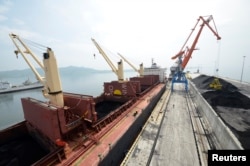A landlocked province in northeastern China is hoping to open new export routes for its trade-starved economy by offering to help a Russian company to expand a nearby Russian port on the Sea of Japan coast.
Provincial authorities in Jilin made the offer in May, signing an agreement with a major Russian logistics company, the privately-owned Summa Group, to cooperate in upgrading the port of Zarubino in Russia's Far East. A private Jilin company already had spent several years trying to modernize another Sea of Japan port on North Korea's coastline, but without much success.
China has been seeking access to North Korean and Russian ports because of a peculiar convergence of three nations' borders on the Tumen River, where Jilin province is cut off from the Sea of Japan's shoreline by distance of only 15 kilometers.
Some analysts say several factors also have combined to make Russia's Zarubino a more attractive target for Chinese investment than North Korea's Rajin port, on the other side of the river.
Chinese state media started devoting more attention to Zarubino earlier this month, publishing a series of articles in which Summa executives provide new details of the project and explain how it could benefit Jilin's economy. In one report, China's Global Times quoted a Zarubino project manager as saying the port expansion will cost $3 billion, with most of the funds coming from Summa and the rest from the Russian government and Chinese investors.
Construction at Zarubino port is due to start next year. If completed on schedule in 2018, Jilin province will have its first-ever direct access to a major year-round ice-free sea port located just 18 kilometers from Chinese territory.
The project includes the building of a port terminal to handle Chinese grain - one of Jilin's main exports - and the upgrading of railway lines connecting the port to the province's nearest city of Hunchun.
Territorial handicap
Northeastern China once had coastline on the Sea of Japan, but lost it when Russia annexed the area under a series of expansionist treaties from 1858 to 1860. Russia used the treaties to expand its boundaries to the mouth of the Tumen, giving itself access to a 15-kilometer stretch of river that previously served as the Chinese-Korean border.
In 2003, China agreed to locate the tripoint of its borders with Russia and North Korea in the middle of the river. By then, Beijing also had secured a right for Chinese vessels to navigate the North Korean-Russian stretch of the Tumen to reach the Sea of Japan.
Carla Freeman, associate director of China studies at Johns Hopkins SAIS, says Beijing has long wanted to use the Tumen River as a trade route and has promoted the idea to its neighbors through the U.N. Development Program. But, she says the obstacles have been too great.
"The Tumen is not a navigable river. In order to make the river a conduit for trade, it would require extensive dredging and other infrastructure development," Freeman said. "There are a lot of questions about the impact of extensive dredging in a very environmentally sensitive region, and this project never has received the kind of financing that it needed to get under way."
In 2008, with the river proposal stalled, China authorized a private Jilin company to upgrade facilities at North Korea's Rajin port to serve as an alternative outlet for Chinese exports. Chinese state media say North Korea granted access rights to the port for 10 years.
Freeman says not much has come of out the deal.
"I don't believe that anything except a very small amount of cargo is going in and out of the Chinese facilities at Rajin yet," she said.
James Schoff, a senior Asia analyst at the Carnegie Endowment for International Peace, says one reason for that lack of progress may be a significant cooling of Chinese-North Korean relations in the past year.
"One never knows what one is going to get with North Korea in these kinds of deals," Schoff said. "So China's decision to expand Russia's Zarubino port could be an 'insurance' policy [in case the Rajin venture does not succeed]."
Russia's advantages
Some analysts say the Zarubino project will make it easier for businesses in Jilin and the similarly-landlocked neighboring province of Heilongjiang to export to southern China and overseas markets in Asia and North America.
Freeman says the main way for those businesses to reach such markets up to now has been to transport their goods through China's congested railways to the overloaded Chinese port of Dalian, located about 1,000 kilometers to the southwest.
Hofstra University geography professor Jean-Paul Rodrigue says an expanded Zarubino port will enable Jilin and Heilongjiang goods to reach ports in southern China and Southeast Asia via shorter and faster container shipping routes skirting the eastern side of the Korean peninsula.
"Zarubino also will give China's northeast industrial heartland an additional gateway to the global market [through the Pacific], making it closer to North American markets," said Rodrigue.
The Russian port also could help the underdeveloped Chinese region to access trade routes to Europe, says Freeman.
"The port could someday be connected with the Trans-Siberian Railway, enabling China to use to it as another conduit for moving goods across Eurasia," she said.
Rodrigue says container ships leaving Zarubino also could reach Europe via the Northern Passage along Russia's Arctic coast - a route that has seen increasing traffic in recent years as global warming keeps shipping lanes ice-free.
"The Chinese have been very interested about using this passage, but it remains a limited option [for trade]," he said.
Freeman says Russia also has a strong economic interest in the project, as it faces Western sanctions for its role in the Ukrainian conflict.
"I think it's natural under the circumstances that we've seen Russia and China moving closer together," she said.



